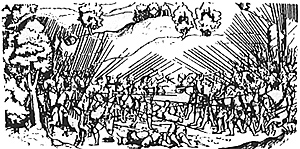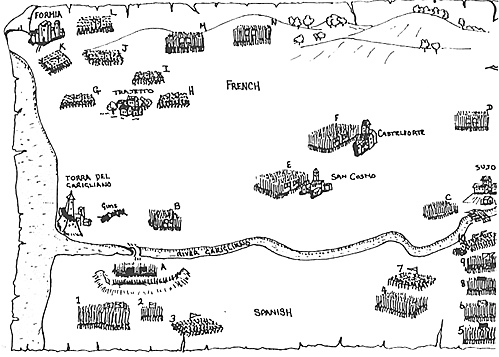
For the solo player, the Renaissance is an excellent period to wargame. Armies are colourful and full of character, whilst the complete lads of uniformity and international use of mercenaries means that with a quick change of flags in the larger scales, your units con be very flexible and represent many different armies.
I prefer to use either 6mm or more recently 2mm, to build the BIG formations of the period. I used to do 15mm until my eyes started to go funny from individually painting all those bloody Swiss pikemen. 25mm are reserved solely for skirmish level games.
I did use WRG's Renaissance rules but found them lacking in period feel or character. Games were too pedantic, so I tinkered with TACTICA and found it fun but the games were still too long, and I was often rushed to come to a conclusion before becoming bored or simply running out of time. Figuring out casualties is simply no fun at 11.30pm.
D.B.M. come to the rescue, with fast and fun games which could be over in 2 hours. Remember, everything can take twice as long when playing solo. More Importantly, the rules convey the correct feel of the disjointed command of these heterogeneous armies in battle.
It is easy to replay historical battles from the Renaissance solo as It's easy to pre-programme one side and take over the role of the other. in a traditional wargame, every unit on the table has to be thought about and moved Individually. Because of the restrictions placed by the limited number of command 'pips' in D.B.M., It encourages you to concentrate on keeping units together in their respective divisons to be moved and fought as a whole.
Fomovo 1495 and Garigllano 1503 are among my favourite solo refights. Fomovo sees a smaller but better French force being ambushed on the march by Italian kondottlerl. The challenge is playing the French and fighting your way out of trouble, I'll write it up with a game report for a future Issue should anybody like this one.
For Garigllano, It's best to take on the role of the Spanish commander with a smaller but vigorous army trying to defeat a much larger but highly dispersed and slow reacting French army. in a traditional face to face wargame, playing the French commander means having to face the frustration of responding to the blitzkrieg style attack of the Spanish in piecemeal fashion.
GARIOLIANO December 27th, 1503
The French army has made a small bridgehead across the River Garigliano and dug in as a breakdown of morale precludes them from pressing the advantage. The Spanish dozed the Initiative and whilst screening the French on their side of the river, marched upstream, threw a bridge of their own across the Garigliano and routed the French army by the suprise and speed of their assault.
Give the French only TWO pip dice. One for use by the troops based around Son Cosmo, Castelforte and Sujo, who will have to -1 for each unit(not base) routed or destroyed, the other die is for the remainder of the army. The Spanish have four pip dice and are the first to move.
French army has approximately 20,000 men, whilst the Spanish 14,500. Both include large numbers of Italians.
The FRENCH
A 4 Gascon (Cross)bowmen (0)
B 6 Gascon Pikes (I) & 4 Italian bowmen (0)
C 4 Norman Pikes (I)
D 4 Norman Pikes (1) & 2 Psiloi (0)
E 14 Swiss Pikes (S) & 2 Psiloi (0)
F 14 Swiss Pikes (S) & 2 Psilol (0)
G 4 Stradiot Light Horse (0)
H 2 French Knights (S)
I 2 Italian Knights (0)
J 2 French Knights (S)
K Italian Knights (0)
L 2 French Knights (S)
M 4 Italian Pikes (I) & 2 Psiloi (0)
N 4 Italian Pikes (I) & 2 Psiloi (0)
2 French Artillery (S)
I have deliberately doubled the number of elements in all the cavalry units. This is due to finding in play that the large number of mounted units with just one individual element didn't quite either look or fight right. Adjust the figures as you see fit for your own games.
The SPANISH
1 12 Italian Pikes (I) & 4 Psiloi (0)
2 2 Spanish Pikes (0)
3 4 Spanish Genitor Light Horse (0) 4/5/6/8/9 each:
4/5/6/8 (each): Spanish Pikes (0) & 1 Blades (0) & 1 Blades (F) & 2 Arquebus
7 4 Spanish Knights (S)
9 4 Italian Stradiot Light Horse (0)
10 4 Italian Stradiot Light Horse (0)

Back to The Gauntlet No. 1 Table of Contents
Back to The Gauntlet List of Issues
Back to Master Magazine List
© Copyright 1994 by Craig Martelle Publications
This article appears in MagWeb (Magazine Web) on the Internet World Wide Web.
Other articles from military history and related magazines are available at http://www.magweb.com